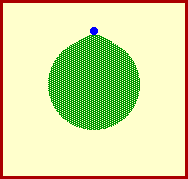Satellite Motion
A GIF Animation
 Second, a satellite is acted upon by the force
of gravity and this force does accelerate it towards the
Earth. In the absence of gravity a satellite would move in a straight
line path tangent to the Earth. In the absence of any forces
whatsoever, an object in motion (such as a satellite) would continue
in motion with the same speed and in the same direction (the
law
of inertia). The force of gravity acts upon a high speed
satellite to deviate its trajectory from a staight-line inertial
path. Indeed, a satellite is accelerating towards the Earth do to the
force of gravity.
Second, a satellite is acted upon by the force
of gravity and this force does accelerate it towards the
Earth. In the absence of gravity a satellite would move in a straight
line path tangent to the Earth. In the absence of any forces
whatsoever, an object in motion (such as a satellite) would continue
in motion with the same speed and in the same direction (the
law
of inertia). The force of gravity acts upon a high speed
satellite to deviate its trajectory from a staight-line inertial
path. Indeed, a satellite is accelerating towards the Earth do to the
force of gravity. That is, if you
were to look out horizontally along the horizon of the Earth for 8000
meters, you would observe that the Earth curves downwards below this
straight-line path a distance of 5 meters. In order for a satellite
to successfully orbit the Earth, it must travel a horizontal distance
of 8000 meters before falling a vertical distance of 5 meters. Since
a horizontally-launched projectile falls a vertical distance of 5
meters in its first second of motion, a orbitting projectile must be
launched with a horizontal speed of 8000 m/s. When launched at this
speed, the projectile will fall towards the Earth with a trajectory
which matches the curvature of the Earth. As such, the projectile
will fall around the Earth, always accelerating towards it under the
influence of gravity, yet never colliding into it since the Earth is
constantly curving at the same rate. Such a projectile is an
orbitting satellite.
That is, if you
were to look out horizontally along the horizon of the Earth for 8000
meters, you would observe that the Earth curves downwards below this
straight-line path a distance of 5 meters. In order for a satellite
to successfully orbit the Earth, it must travel a horizontal distance
of 8000 meters before falling a vertical distance of 5 meters. Since
a horizontally-launched projectile falls a vertical distance of 5
meters in its first second of motion, a orbitting projectile must be
launched with a horizontal speed of 8000 m/s. When launched at this
speed, the projectile will fall towards the Earth with a trajectory
which matches the curvature of the Earth. As such, the projectile
will fall around the Earth, always accelerating towards it under the
influence of gravity, yet never colliding into it since the Earth is
constantly curving at the same rate. Such a projectile is an
orbitting satellite.|
Launch Speed less than 8000 m/s Projectile falls to Earth
|
Launch Speed less than 8000 m/s Projectile falls to Earth
|
|
Launch Speed equal to 8000 m/s Projectile orbits Earth - Circular Path
|
Launch Speed greater than 8000 m/s Projectile orbits Earth - Elliptical Path
|